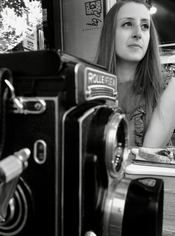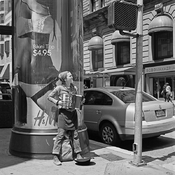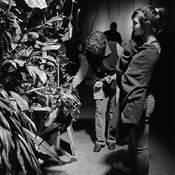What about the Mamiya 645, maybe the 1000s. I was using Mamiya C33 & C3 cameras from the mid 1970s until they were stolen, I replaced them with a plain Mamiya 645 & 1000s, I really enjoyed using them. I lent the plain 645 body to a friend as a spare body, I got it back not working, and didn't see her for over 25 years. However, she's giving me a newer model, later this month

I mostly shoot LF and carried a Leice M3 when out shooting, but I found prints from35mm negatives didn't sit well alongside those from 5x4 and 10x8 negative in exhibitions. So after some thought I bought a Yashica 124 (on this Forum 2006/7) to use alongside 5x4 while living abroad, That proved to be an excellent decision as the print quality fits perfectly alongside LF, and I also really like using the square format for some images. (I shoot to format). I had also been given a Rolleiflex 3.5 E2 back in the late 1980s, the shutter was sticking, the owner said he'd put less than a dozen films through the camera, the lubricants had dried up. I had it serviced at the same time as the Yashicamat 124, and left it to use here on visits back to the UK.
These days I still use the Mamiya 645 1000s when shooting portraits or working with models, but I much prefer the Rolleiflex when out shooting landscapes. I acquired a second Rolleiflex an Automat with an Opton Tessar lens, cheap, but it had been serviced, at a Flea market. That'snow my main TLR, the Yashica has been sold.
I loved using my C33 & C3, I had a standard and wide angle lens, but they were heavy. The Mamiya 645s with a prism finder were/are just like using a scaled up 35mm SLR, and I liked the 15 shots per 35mm roll, but again not light. But my Rolleiflex cameras are relatively light, compact and fun to shoot with, and the results excellent.
TLR Parallax error at 3-4 feet with a 75-80mm lens on a 6x6 camera is relatively minimal - the displacement is just ~2 inches - and can easily be dealt with (if necessary) by raising the camera that amount just before exposure.
In 50+ years, I've never lost a shot because of it.
I shot a jewellery catalogue in 1976 with a Mamiya C33, the camera did have parallax correction on the screen, but at the distance I was working at useless. I did exactly what you mention, marking the tripod column to give the correct displacement. It was easy and worked.
Ian















